“Teaching/Feeling/Writing” is an essay in dialogue form. It has been shaped by months and years of conversation between Alec Magnet and T Meyerhoff, with and about Eve Kosofsky Sedgwick, and formally inspired by “Divinity: A Dossier, A Performance Piece, A Little-Understood Emotion,” which Sedgwick wrote with Michael Moon. As in “Divinity,” the identified speaker may not be the one who wrote a particular piece of dialogue. However, anything “spoken” by the quoted speakers is accurately attributed.
Dramatis Personae (in order of appearance)
Original Speakers
Alec Magnet: Former student of Eve Sedgwick, doctoral candidate in English at the Graduate Center, City University of New York, and adjunct lecturer of English at the City College of New York.
T Meyerhoff: Former student of Eve Sedgwick, doctoral candidate in English at the Graduate Center, City University of New York, and adjunct lecturer of digital literacy and writing at the CUNY School of Professional Studies.
Quoted Speakers
Eve Kosofsky Sedgwick: Queer reader, writer, and pedagogue extraordinaire.
Robert McRuer: Queer and crip theorist, comp scholar, professor at George Washington University.
Jonathan Alexander and Jacqueline Rhodes: Co-authors and queer comp scholars. Alexander is a professor at UC Irvine; Rhodes is a professor at CSU San Bernardino.
Ian Barnard: Queer comp scholar, associate professor at Chapman University, professor emeritus at CSU Northridge.
Mark McBeth: Queer comp scholar, former student of Eve Sedgwick, and teacher of both Alec and T, associate professor at the Graduate Center, City University of New York, and John Jay College of Criminal Justice.
C. Jacob Hale: Queer and trans theorist, philosopher, professor at CSU Northridge.
Douglas Crimp: Art historian, queer theorist, professor at the University of Rochester, friend and colleague of Sedgwick.
James Kincaid: Literary critic, queer theorist, professor at University of Southern California, friend and colleague of Sedgwick.
SCENE
(A bare stage saturated with pinkish light. Eve Kosofsky Sedgwick appears on a scrim at the rear of the stage. She smiles and gives a little wave.)
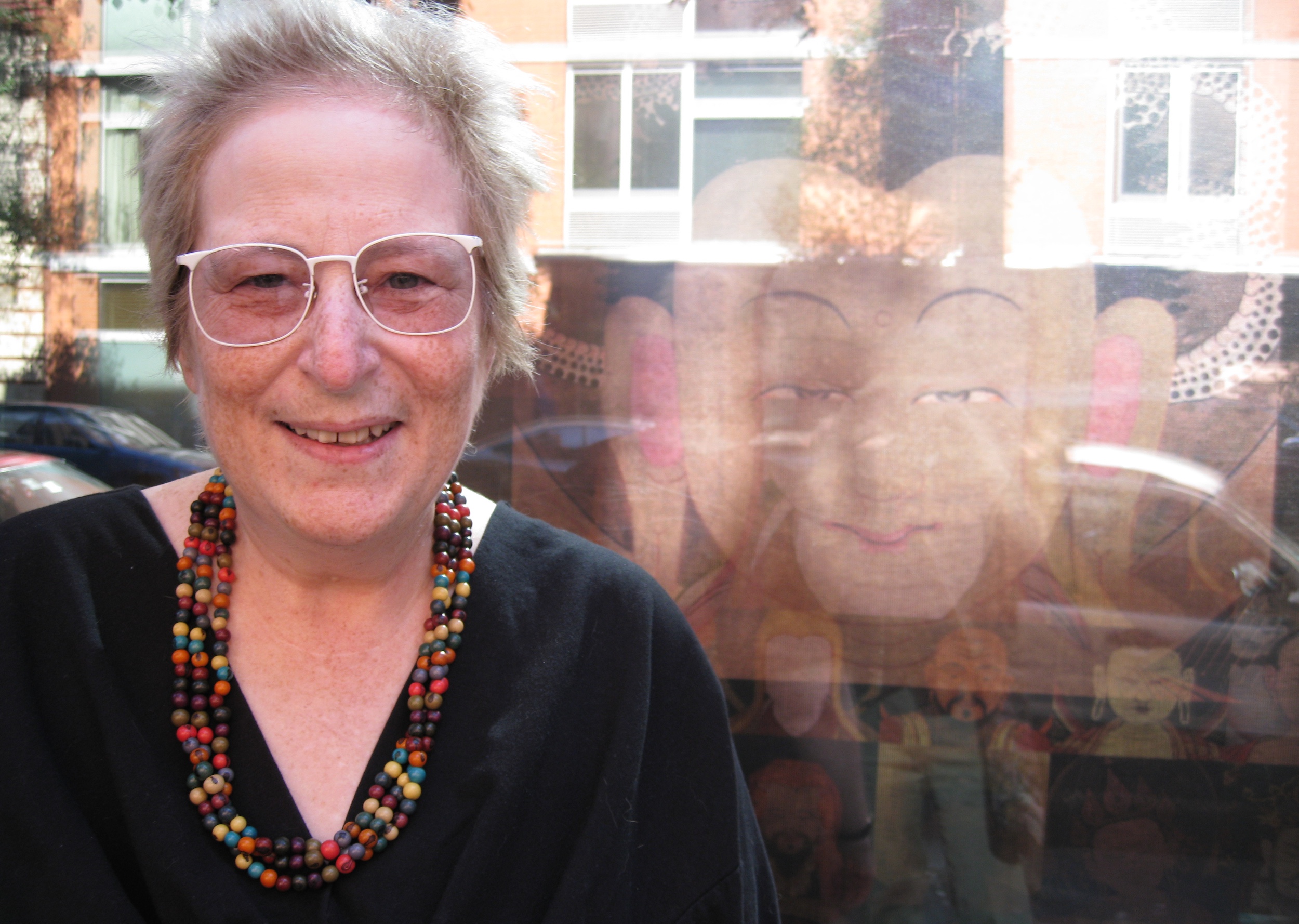
Eve Kosofsky Sedgwick. Photo by H. A. Sedgwick.
Eve
The depressing thing about the Christmas season—isn’t it?—is that it’s the time when all the institutions are speaking in one voice. . . . They all—religion, state, capital, ideology, domesticity, the discourses of power and legitimacy—line up so neatly once a year, and the monolith so created is a thing one can come to view with unhappy eyes. What if instead there were a practice of valuing the ways in which meanings and institutions can be at loose ends with each other? What if the richest junctures weren’t the ones where everything means the same thing? (Tendencies 5–6, emphasis Sedgwick’s)
That’s one of the things “queer” can refer to: the open mesh of possibilities, gaps, overlaps, dissonances and resonances, lapses and excesses of meaning when the constituent elements of anyone’s gender, of anyone’s sexuality aren’t made (or can’t be made) to signify monolithically. The experimental linguistic, epistemological, representational, political adventures . . . (Tendencies 8)
(Eve fades.)
Alec
I miss that voice.
T
I hear it still. Especially in relation to teaching. I mean, one of the things writing can refer to is the open mesh of possibilities, gaps, overlaps, dissonances and resonances, lapses and excesses of meaning; the experimental linguistic, epistemological, representational, political adventures that pen and keyboard afford and the page and web transmit are, or can be, at the heart of writing instruction.
But, for adjuncts especially, comp teaching can feel deeply unqueer. The nascent queer turn in composition studies has begun to articulate this feeling that, despite decades of effort regarding both theory and practice, . . .
(On the scrim, pages from recent articles by queer composition scholars begin to flutter by. The first few leaves, written by Robert McRuer, read:)
Robert
. . . composition in the corporate university remains a practice that is focused on a fetishized final product, whether it be the final paper, the final grade, or the student body with measurable skills. . . . Individual instructors—and even institutions—may focus on process, . . . [but c]ontemporary composition is a highly monitored cultural practice, and those doing the monitoring (on some level, all of us involved) are intent on producing order and efficiency where there was none and, ultimately, on forgetting the messy composing process and the composing bodies that experience it. (53)
Alec
That pressure can be felt much more subtly and pervasively just in the reality that our students need certain basic competencies—which they often arrive in our classrooms without—in order to make it through college. In many institutions, the bulk of the responsibility for providing them with these skills falls explicitly—and impossibly—on the often contingent instructor teaching them their one semester of first-year comp.
T
I remember back to when I taught my first comp class. I imagined I would be helping students strengthen their writing, that my major effort would be to propel and refine their verbal expression into precise, deeply felt and powerful writing.
What I discovered was that my students had been severely, profoundly, deprived. The kind of writing that I took for granted, felt unquestionably entitled to, casually regarded as my human inheritance, was a foreign country to them. When I wanted them to express something “in your own words,” I mistook that for an easily accomplished, low-stakes, unthinking act. Not only was it difficult for many of my students to do, it was an abstract, vague, concept that was difficult to understand.
So this seemed to be job #1. The point was very much not to demand that they meet the benchmark of producing [pointing to the scrim] . . .
Robert
. . . the highly routinized, “well-made” essay; the sonnet sequence; the supposedly secure masculine or heterosexual identity . . . (49)
T
. . . but instead to instill what I’ve been thinking of as a sense of ownership. I want my students to identify as writers (and therefore, of course, as readers). I want them to understand, to feel, to know how to feel through their writing.
Queerness in the way that Sedgwick describes it—openness, excesses, gaps, adventures—for me is central to this process, not only when it comes to feelings and identities, but also to the actual practices and products and experiences of writing.
(Among the pages fluttering by on the scrim, several more flicker into focus, first written by Jonathan Alexander and Jacqueline Rhodes, and then by Ian Barnard. They read:)
Jonathan and Jacqueline
Queerness has the potential to stretch our sense of not only what can be composed, but also of how it can be composed. . . . We understand . . . the very real and material need to help students develop the kinds of compositions—the kinds of composure—that make them legible in the marketplace, not just of ideas but of hard currency. But we want also to make room for the kinds of writing—and the kinds of subjects—that challenge such composure, that offer rich, capacious, and (yes) excessive ways of thinking and writing. (183)
Ian
The queer in that new Queer Studies first year composition course that I am charged with developing can’t just be about content. It also has to be about queer grading practices, queer forms of writing, queer classrooms, queer assessments . . . , queer academias. What about queer methodologies . . . ? What about queer genre . . . ? What is the relationship between queerness and plagiarism . . . ? How do queer stylistic disruptions relate to recent work in our fields . . . ? (sec. 10)
Alec
One place to start is by focusing not just on how to write, but also on how to do things with writing, and on how those things feel—performativity and affect, as in the subtitles to Sedgwick’s Touching Feeling: Affect, Pedagogy, Performativity and to this “Interlude.” In the chapter “Paranoid Reading and Reparative Reading,” she begins her meditation on reparative queer reading by shifting attention to the performative aspects of knowledge or of reading—to what it can do: what affective, intellectual, even political effects it can have on the people and the world around it.
As Sedgwick describes it—in words I love to repeat—reparative reading responds to a culture “inadequate or inimical” to queer readers’ nurture and even survival with the desire to generate practices of loving and identifying, as well as things to love and identify with: “it wants to assemble and confer plenitude on an object that will then have resources to offer to an inchoate self” (149).
In the same way, her reflections on writing—particularly on queer writing—emphasize the questions of what writing can accomplish and how, formally and emotionally, it can do so.
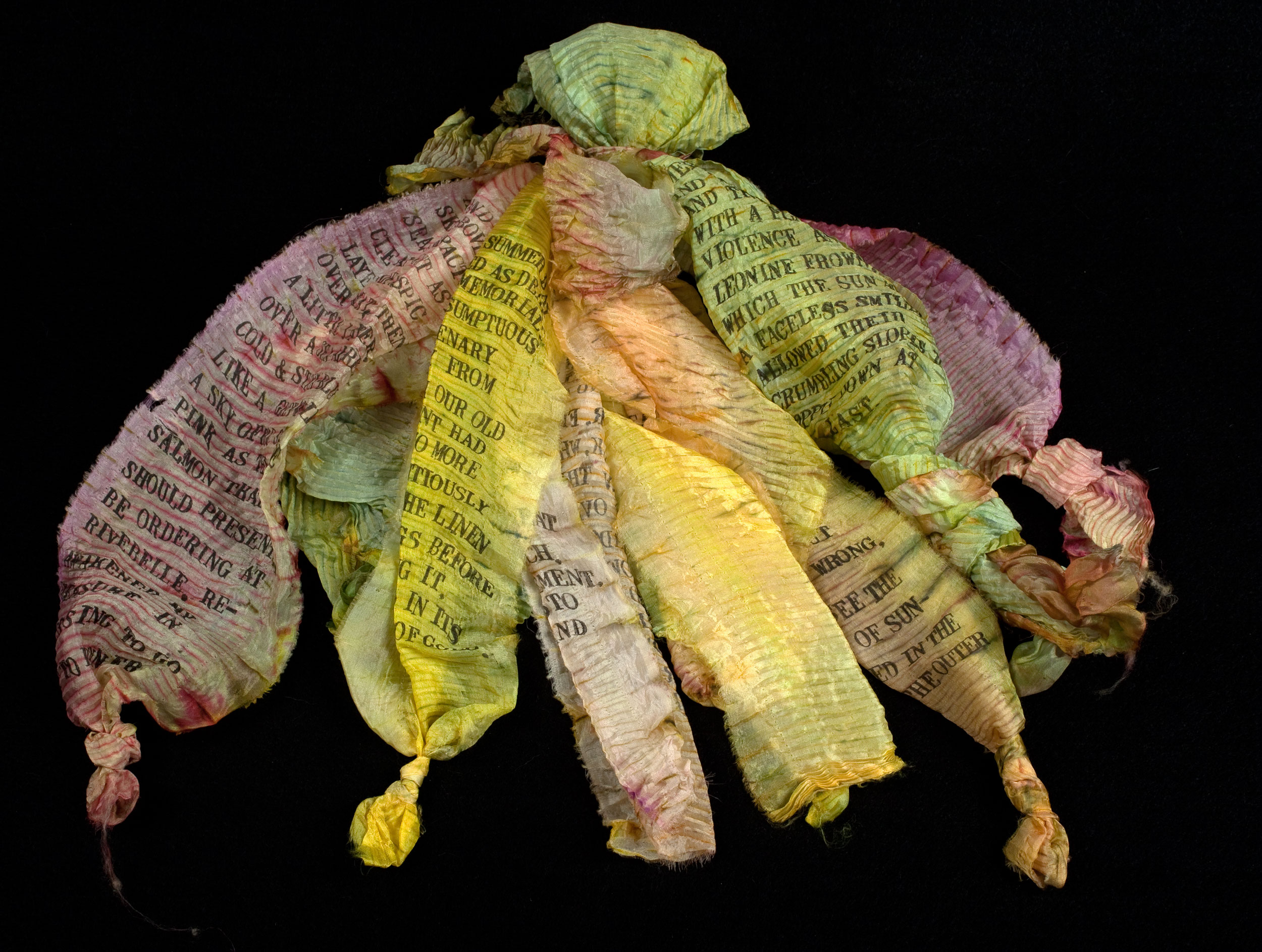
Eve Kosofsky Sedgwick. Polyp. Photo by Kevin Ryan.
T
That focus on what the students can do with writing and on how they can do it may be a way to win the converts to writing. As they start experiencing their power to wield the creative, performative force of their own writing in specific, and functional ways, they will have much more reason to invest the craft of writing with emotional and intellectual excitement.
Ian (in pages on the scrim)
Writing Like Eve: . . . What can we say about [Sedgwick’s] writing style and queerness? What can the way she writes teach us about writing, about teaching writing, about queer writing, about queer composition? (sec. 18)
Alec
At Duke, where she was a professor from 1988 to 1998, Eve taught a class precisely to foster those kinds of relationships to writing—“Experimental Critical Writing.” She included a detailed explanation of the course on her website at Duke, which Peggy Phelan and Jill Lane collected in their 1998 volume, The Ends of Performance.
(Eve reappears on the scrim at the back of the page.)
Eve
I’ve taught “Experimental Critical Writing” at both undergraduate and graduate levels. Both work consistently well, and many of the same assignments are appropriate for both levels. With undergraduates, the course works as an alternative to more generically-based creative writing classes. For graduate students, its main function is to trouble and interrupt the process of professionalization: to make sure that students at the anxious, rather numbing pre-professional level will not lose touch with their own writerly energies.
The point of having frequent, short, tightly-framed assignments is to overcome students’ (especially graduate students’) inhibitions about experimentation. With only a couple of exceptions, the assignments are organized around very specific formal choices and/or constraints, and students choose their own subject matter. (“Teaching ‘Experimental’” 104–5)
Alec
The first and last assignments of the course, for example, ask students to engage directly with J. L. Austin’s notion of performative utterances, speech acts that accomplish an action just by being spoken: “I welcome you,” “I apologize,” or Austin’s classic—and much more complicated—example, “I do [take this person to be my lawfully wedded . . . ].” Sedgwick encourages her students to think about the social and discursive contexts necessary for various acts: a marriage makes use of witnesses and a license, while an excommunication implies membership in a community that the speaker has authority to cast people out of. For the first assignment, students write a performative utterance. A real one:
Eve
. . . if your performative utterance is ‘I invite you to a party at my house tonight at 8,’ then there’d better be a party when we get there!” (“Teaching ‘Experimental’” 107)
T
The final assignment asks students to join into small groups to come up with a public performative utterance by which something might actually be changed, perform it, document the process, and then—individually or collectively—find some way to evaluate it. Here are the questions she asks students to think about:
Eve
What do you think needs to change?
What representational acts could effect change?
What are the relations of address involved in these acts? (I.e., who is speaking, and to whom?)
Who is interpreting these acts, and how? How much control, and what kinds of control, do you have over this interpretive process?
What is the relation of these acts to pre-existing forms and conventions of utterance?
What is the relation of these acts to pre-existing media of public representation and advertising? (“Teaching ‘Experimental’” 115, emphasis Sedgwick’s)
T
Project-based learning. You’d learn a lot about how writing—and language in general—“work” from doing these assignments, both in the sense of their inner workings and of the work they can accomplish. But you’d do it by figuring out what action you (or your small group) want to perform and then how you can (and cannot) set about it. Does that show what “your own” words are? Would it provide a sense of ownership by students over student writing? If nothing else, it gives them the opportunity to identify with the intentions behind their writing—and to experience its power to affect the world around them.
Alec
Also play-based learning, something that the word “interlude” in our title gestures toward.
T
Interlude: a brief, often light-hearted performance inserted between the acts of, for example, a medieval morality play. It traces its etymology back to the Latin word ludus, for play or game . . .
Alec
. . . also joke . . .
T
. . . sport . . .
Alec
. . . religious festival . . .
T
. . . school.
Alec
Mark McBeth—another CUNY professor we’ve both worked with—gets at some of the same amalgamation of performance, ritual, education, and play in his (to his graduate students, famous) conceptualization of first-year composition students as drag queens:
(A video—which can be seen here—appears on the scrim.)
Mark (transcribed from video)
Not the professional, seasoned queens—with the gelled lighting, fabulously detailed costumes, and crooning, torch-song voices—but the messy ones, who show up at open mike night for their first wobbly performance. They begin by braving the open mike in their rag-tag get-up, all twisted wig, ill-fitting dress, and smeary-bleary make-up. But during their performances, they learn something from composing themselves on the stage and then rehearsing again and again. Words that were lip-synched poorly find meaning. A pandemonium of ideas becomes well-staged and finds a plot. . . . Somehow eventually my disheveled freshman-year composition drag queens find a sparkly, bedazzled voice of their own, and they shine. (5)
T
At the same time, “there’d better be a party when we get there!”
Alec
Eve only played for real.
T
The question of how students might not be able to accomplish the work they want their performative utterance to do—in particular, of how social and discursive contexts might complicate the doing—is especially relevant for teaching first-year comp.
Alec
This is part of why I love Eve’s second-to-last assignment for “Experimental Critical Writing,” another small-group project responding to Wayne Koestenbaum’s 1993 book, The Queen’s Throat. (Full disclosure: Wayne is my dissertation advisor). The assignment directs students to “[n]ote the variety of approaches to excavating a single topic, opera—and specifically, note the ‘scrapbook’ form, the short sections with frequent new beginnings, and the movements back and forth between personal history and a larger, social history” (“Teaching ‘Experimental’” 114).
T
But wait. Scrapbook. Let’s connect that to her Graduate Center course, “How To Do Things with Words and Other Materials.” Because the scrapbook form has a lot to say about “your own” words. It is an example of . . .
Eve
. . . genres that make unconventional use of the materiality of both the written word and its support . . . each exploring different aspects of the complex relations among language, materiality, and visuality. (“How to Do Things”)
T
. . . which definitely connects with . . .
Eve
. . . the ways that paper, fabric, thread, and other supplies press back so reliably, so palpably, against my efforts to shape them according to models I’ve conceived. . . . Instead, there are second-by-second negotiations with the material properties of whatever I am working on . . . active in that space of suspended agency. (The Weather in Proust 83)
T
“Class, today we will learn to make a composition. Please examine the books, articles, paints, fabrics and sequins in front of you. You may want to use a whole page, a sentence, mixed paints, cuttings, glue, color, sparkle, scraps . . . as you wish. Using any parts you choose, assemble, arrange, sequence and layer them. You must not use any of your ‘own words.’ You must not cite any of your sources. If you follow these instructions, you will not be plagiarizing.”
For example, none of these words are Eve’s:
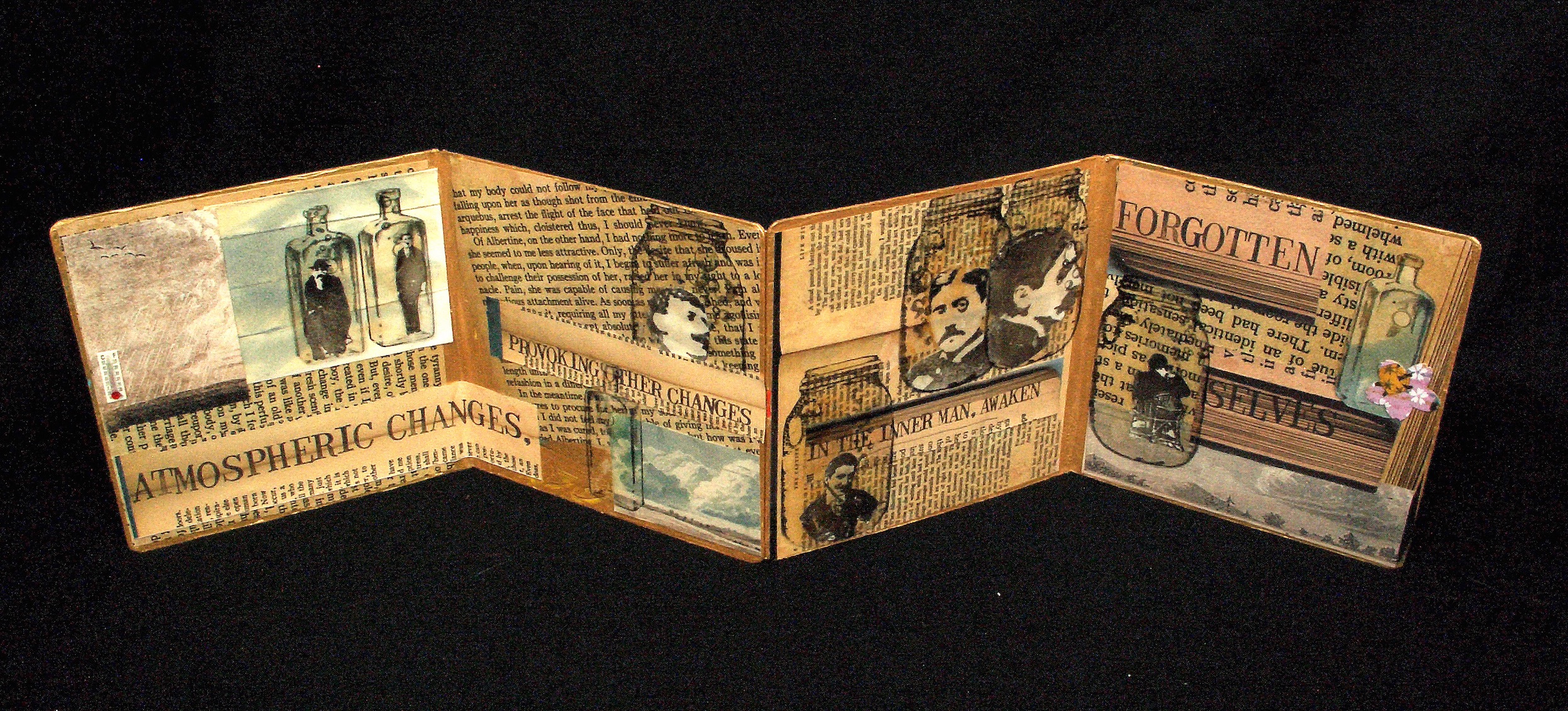
Eve Kosofsky Sedgwick. Untitled. Photo by H. A. Sedgwick.
No wait. All of them are.
Alec
Eve’s Queen’s Throat assignment translates this interpersonal, reusing, collage approach into the composition of written texts. Each group is asked to settle on a topic that has some autobiographical resonance for all of its members, then compose a “multivoiced, multiperspective, multihistory archaeology of this topic” that “draw[s] from both personal experience and historical record” and evokes “different private and public spaces, different personalities, different bodies experienced from the outside and the inside” (“Teaching ‘Experimental’” 114, emphasis Sedgwick’s).
What I love about this assignment is that it requires the groups to interweave not only several voices, first-person and otherwise, but also several different levels of discourse—personal narrative, historical report, critical analysis, and so on. These discursive level-shifts dramatize the code-switching, the masquerade performance, we all do when writing across different forms and genres.
This has two seemingly opposite effects. First, it clarifies the differences among these types of writing—just as, when you want to explain how plot summary is not the same thing as analysis, you assign one piece of writing that is only plot summary, then another that presents its own interpretation.
But secondly, it refuses to make these differences absolute. Quite the opposite: I imagine that the historical and analytic sections of writing, as with The Queen’s Throat, are vivid with interest precisely because of their juxtaposition with affect-laden personal narrative and emotional expression. The fact that several different writers must each contribute their own personal investments to the group project further emphasizes this balance. Not everyone will feel the same way, and yet everyone’s experiences together comprise the knowledge that the text presents, enlivening the end product with the scrapbook accumulation of its creators’ emotional investments in its topic.
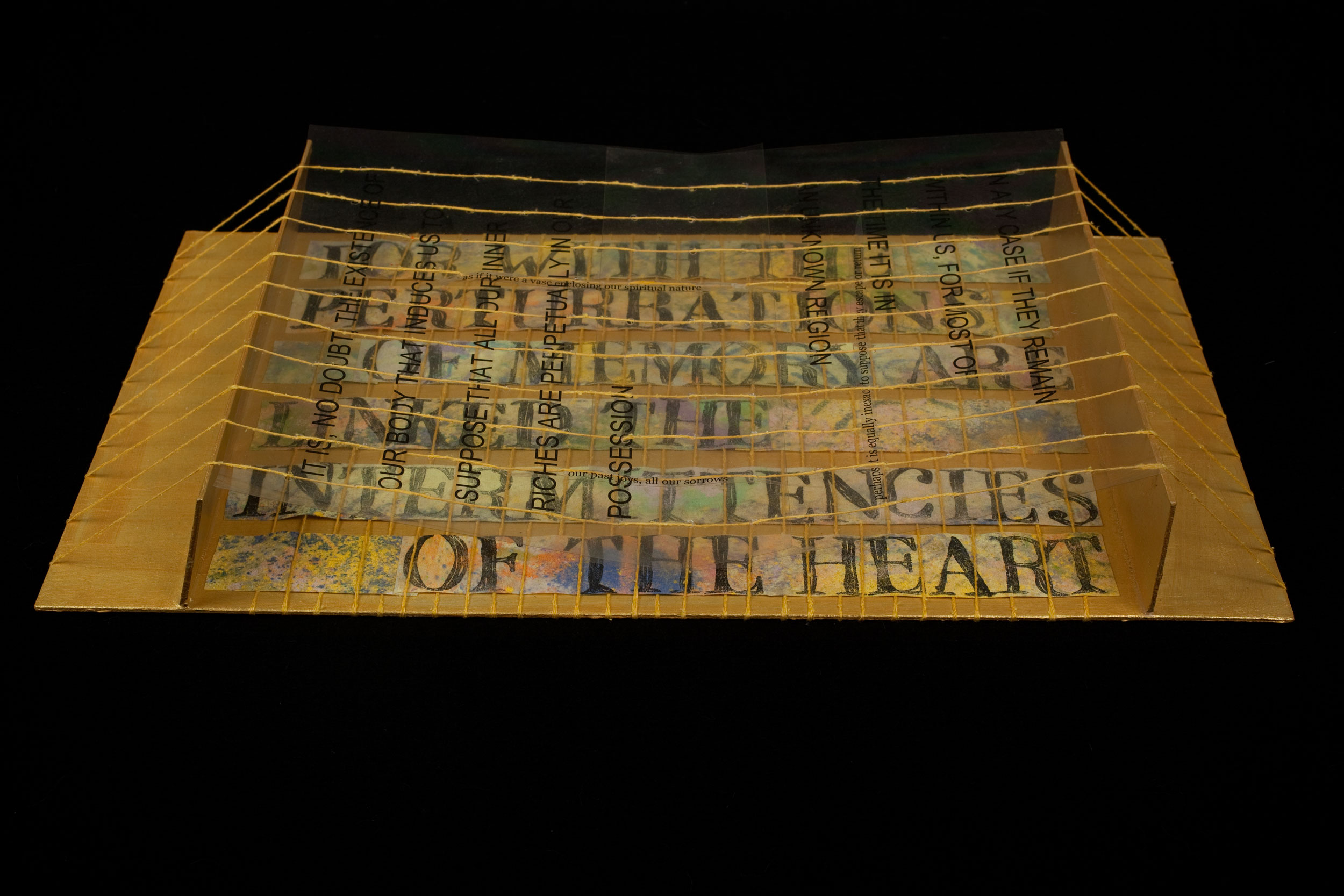
Eve Kosofsky Sedgwick. Loom Book. Photo by Kevin Ryan.
T
Hmm. Each member of the group would be using words that aren’t their own, again without plagiarizing. Is there something about woven-ness and layered-ness that makes queer writing? Queer reading? Queer feeling?
Alec
I think there is a particular type of emotional embeddedness or inter-woven-ness at the heart, for example, of Eve’s assignment. This is not the same thing as one’s situatedness within cultural and historical contexts, though the two can be studied so that they reinforce each other. The activity of de-composing cultural narratives of sexuality, gender, able-bodiedness, race, what have you, when performed self-reflectively, may pave the way for both student and teacher to recognize those queer gaps and dissonances and possibilities and excesses of meaning within their own identities that Eve so generatively describes as queer in “Queer and Now.” In turn, this recognition may enable the discovery or the emergence of new, more complex feelings.
I have in mind how she describes the possibilities of a more open project of self-recognition in her 1997 response to C. Jacob Hale’s theorization of leatherdyke communities and practices, as . . .
Eve
. . . something like identification with what is, at any given moment, understood to be the growing edge of a self. That is to say, a project of self-recognition may arise from something very different than the desire to fix, to render self-evident or self-identical or unchanging, the boundaries of a personhood. There seems to be a kind of spiral shape to these trajectories of identity. Moments of daring surmise and cognitive rupture-moments, that is, in which new speculations arise about what now constitutes the growing edge of this self-may be followed by moments of experiential reflection, forward projection, trial and error, and reality testing of such surmise: is this, at this moment, the possible site of a consequential change that will prove in some way meaningful in terms of one’s own history. (238)
(Pages by Hale begin to appear on the scrim . . . )
Jacob
Is a leatherdyke daddy a woman or a man? Is a leatherdyke boy a woman or a man or a boy? These questions, I think, are badly misguided. . . . [S]ome leatherdyke daddies and boys are women, some are not, and that in many cases there is no fact of the matter. (231)
Alec
We are trying to imagine a queer pedagogy that attends in particular to the complexities, differences, and inter-woven-ness of different people’s feelings, a pedagogy that makes space for engagement with messy, multi-faceted processes, emotions, and selves. This may happen on the level of topic. In my literature classes, for example, I foreground the ambiguous, idiosyncratic, unexpected feelings embedded within the texts we discuss.
( . . . followed by pages from Douglas Crimp and James Kincaid.)
Douglas
“People are different from each other.” This is, of course, Axiom 1 from the introduction to Epistemology of the Closet, but I take it to be much more thoroughly axiomatic for Sedgwick’s writing generally and what I’ve learned most from it: the ethical necessity of developing ever finer tools for encountering, upholding, and valuing other's differences—or better, differences and singularities—nonce-taxonomies, as she wonderfully names such tools. In one of the many deeply moving moments in her work, Sedgwick characterizes this necessity in relation to the “pressure of loss in the AIDS years”—years in which we sadly still live—“that the piercing bouquet of a given friend’s particularity be done some justice.” (57, quoting Epistemology 22–23)
James
Which brings us to feelings, to the reparative criticism we do, Eve and I, and to the search for affect and for a way to talk about it. Strange that even in the heyday of the studies of readers and what was going on inside them, little attention was given to feeling. What happens if I feel embarrassed, aroused, bored, fascinated, stunned, amused, saddened? . . . Don’t ask Stanley Fish. (239)
Alec
If our theatrical “Interlude” can be said to have a thesis, it is that this attention must happen both on the level of feelings and on the level of practice and form—in process-driven assignments, in space for personal investment, and in explicit tolerance for creativity, experiment, and failure.
Part of what it means to teach queerly is providing the spaces in which certain types of emotional thinking or work are available—and in which certain emotions themselves can be appropriated, internalized, and made use of, rather as in a collage. Or, better yet, literally in a collage, as well as in writing, in the classroom, in life in general.
That’s certainly one of the things Eve meant her own teaching—and her own writing—to do. She says as much in one of my Eve favorites, “Teaching/Depression.” Speaking of her memoir A Dialogue on Love, she writes:
Eve
Of course it’s easy to fear that autobiography merely exposes a bumptious narcissism, reeking with its primordial first person singular. I’m much more struck by something else: the use of these pages, if anything, to aerate, expose, and ideally to disable or “burn out” the potency of certain violent defenses. At least, that ambition is central to the way A Dialogue on Love is constructed. For me, the interest of narrating this psychotherapy lies hardly at all in reconstructing childhood material, as it happens—or even adult motives. In fact, already, when I reread it, the accounts of myself seem dangerously skill-less and unliving. Instead, what I wanted to make palpable—and available—was the quality of a specific listening space, a space that is open to every anxiety but resists propelling onward its fatal itinerary. . . . I think it’s clear that a pedagogical desire underlies this narrative—desire both to inhabit but equally to offer this radically, ever newly unpreempted space. (3)
T
Yes! The page can be an unpreempted space. Students can perform their identities in their writing. But: You must do it correctly! You must use grammatical Standard English. You must use quotation marks and a consistent citation format. You must write on the subjects I assign, even if I make you create your topic. And most important, you must say it in your own words!
Can I tell my students (and here again I speak as a migrant adjunct), “Honestly, citation is a dying practice, predicated on an outdated notion of textual ownership”? No. And not only this. So very many options are foreclosed to me. The space of my classroom has been highly preempted.
For example: A student was researching some topic suitably distant but adequately studied for comp purposes. She handed in a paper that consisted almost entirely of quotations. Walter Benjamin reincarnated. But that was clearly unacceptable. I told her the paper had to be her own original writing. She said she didn’t know anything about the subject other than what her sources provided. Therefore, if she didn’t quote, it would be plagiarism. We were at a standstill. What if you don’t have your own words?
What I really want to teach my students, through teaching writing, is something only they can know. I want them to write themselves. They are the only experts.
Alec
And yet, they may know next to nothing about how to do that. Obviously in several different senses they have and know themselves, and have and know their thoughts, they have and know their feelings. What they may not know, and may not have, are the emotional, theoretical, or intellectual tools, nor the experiential sophistication, to organize and interpret, write and read, an unfamiliar or unprocessed identity or feeling. Which might sound like a contradiction: either you have something or you don’t.
Eve
In modern Western common sense, after all, to learn something is to cross a simple threshold; once you’ve learned it, you know it. Learning the same thing again makes about as much sense as getting the same pizza twice. . . . Colloquially, but only colloquially, even English differentiates among say, being exposed to a given idea or proposition, catching on to it, taking it seriously, to having it sink in, and wrapping your mind around it. (Touching Feeling 167)
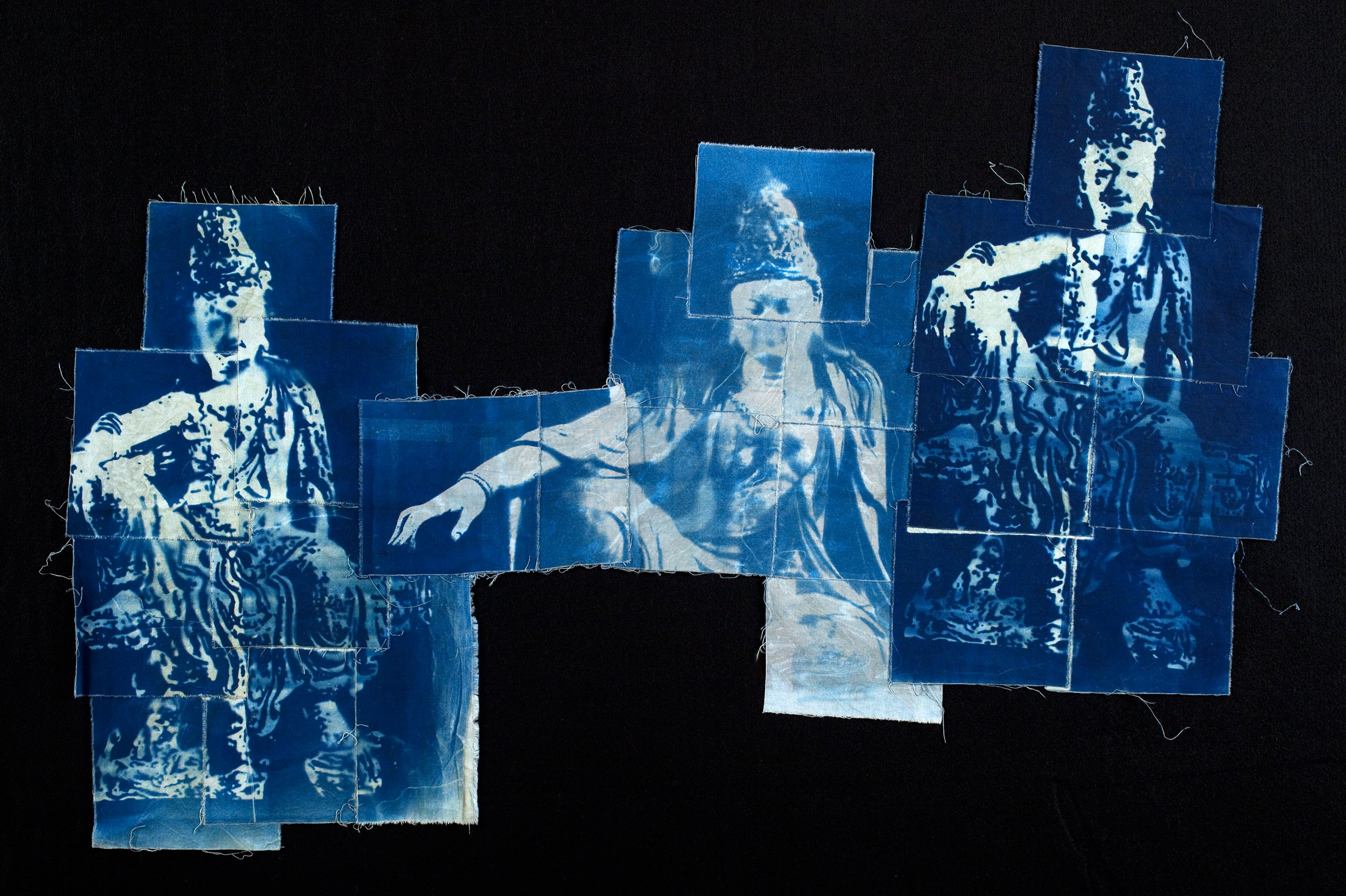
Eve Kosofsky Sedgwick. Untitled. Photo by Kevin Ryan.
Alec
And this is precisely where queer pedagogy excels, because whatever is under consideration need not exclude anything else. When Eve talks about realization in “Pedagogy of Buddhism”—
Eve
When Elizabeth Palmer Peabody [teacher and Transcendentalist] one day walked right smack into a tree, she was naturally asked whether she had not seen it in her path. “I saw it,” she became famous for replying, “but I did not realize it.” (Touching Feeling 167)
T
—she shows how these various threads we’ve been braiding—emotional literacy and writing proficiency, queer reading and a writerly identity—can be woven into a usable cloth, a textile of text, so to speak. And one which is an “open mesh of possibilities, gaps, overlaps . . .
(T’s voice slowly fades, as Eve’s voice comes up.)
Eve
. . . overlaps, dissonances and resonances, lapses and excesses of meaning . . .
(Lights down and out.)
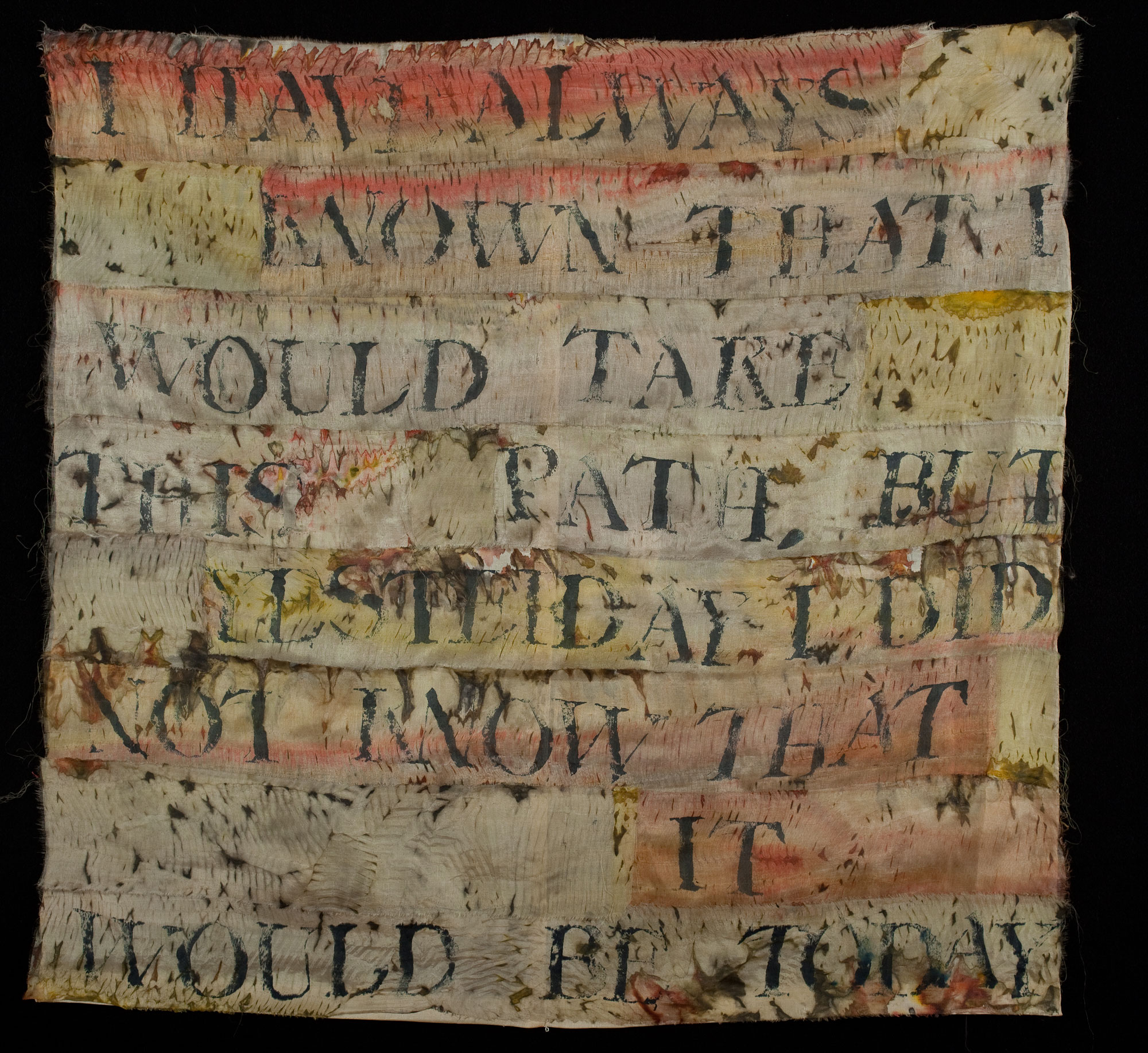
Eve Kosofsky Sedgwick. Untitled (“I have always known that I would take this path, but yesterday I did not know that it would be today.” Poem by Ariwara no Narihira). Photo by H. A. Sedgwick.
Acknowledgements
All images © H. A. Sedgwick, used with permission.
We warmly thank Hal for his kind help and generosity.
Works Cited
Alexander, Jonathan, and Jacqueline Rhodes. “Queer: An Impossible Subject for Composition.” JAC 31.1–2 (2011): 177–206. Print.
Barnard, Ian. “Queer Writing.” College Composition and Communication Online 1.1 (2012). Web. 23 Sept. 2014.
Crimp, Douglas. “Mario Montez, For Shame.” Gay Shame. Ed. David M. Halperin and Valerie Traub. Chicago: U of Chicago P, 2009. 63–75. Print.
Hale, C. Jacob. “Leatherdyke Boys and Their Daddies: How to Have Sex without Women or Men.” Social Text 52/53 (1997): 223–36. JSTOR. Web. 23 Sept. 2014.
Kincaid, James. “When Whippoorwills Call.” Regarding Sedgwick: Essays on Queer Culture and Critical Theory. Ed. Stephen M. Barber and David L. Clark. New York: Routledge, 2002.229–41. Print.
Koestenbaum, Wayne. The Queen’s Throat: Opera, Homosexuality, and the Mystery of Desire. New York: Vintage, 1993. Print.
McBeth, Mark. “Enacting Eve: A Testimonial Performance.” College Composition and Communication Online 1.1 (2012). Web. 23 Sept. 2014.
McRuer, Robert. “Composing Bodies; or, De-Composition: Queer Theory, Disability Studies, and Alternative Corporealities.” JAC 24.1 (2004): 47–78. Web. 23 Sept. 2014.
Sedgwick, Eve Kosofsky. A Dialogue on Love. Boston: Beacon, 1999. Print.
—. Epistemology of the Closet. Berkeley: U of California P, 1990. Print.
—. “How to Do Things with Words and Other Materials.” The Graduate Center, City University of New York. N.d. Syllabus. EveKosofskySedgwick.Net. Web. 23 Sept. 2014.
—. “Response to C. Jacob Hale.” Social Text 52-53 (1997): 237–39. JSTOR. Web. 23 Sept. 2014.
—. “Teaching ‘Experimental Critical Writing’.” The Ends of Performance. Ed. Peggy Phelan and Jill Lane. New York: New York UP, 1998. 104–15. Print.
—. “Teaching/Depression” The Scholar and Feminist Online 4:2 (2006). Web. 23 Sept. 2014.
—. Tendencies. Durham: Duke UP, 1993. Print.
—. Touching Feeling: Affect, Pedagogy, Performativity. Durham: Duke UP, 2003. Print.
—. The Weather in Proust. Ed. Jonathan Goldberg. Durham: Duke UP, 2011. Print.
Sedgwick, Eve Kosofsky, and Michael Moon. “Divinity: A Dossier, A Performance Piece, A Little-Understood Emotion.” Sedgwick, Tendencies 215–51.
